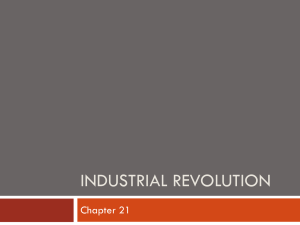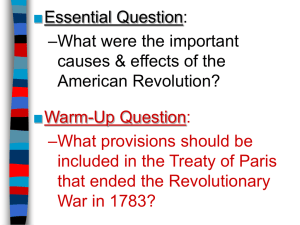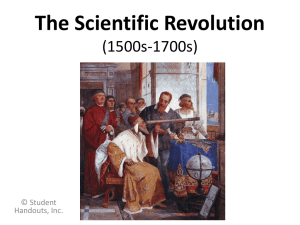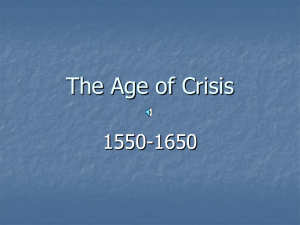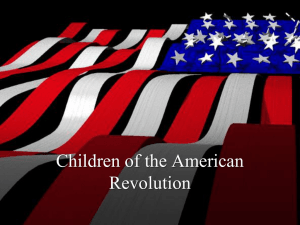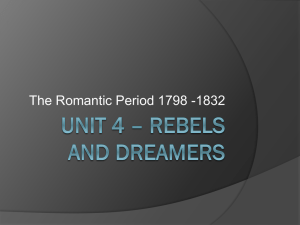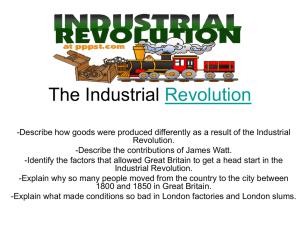The Industrial Revolution
advertisement
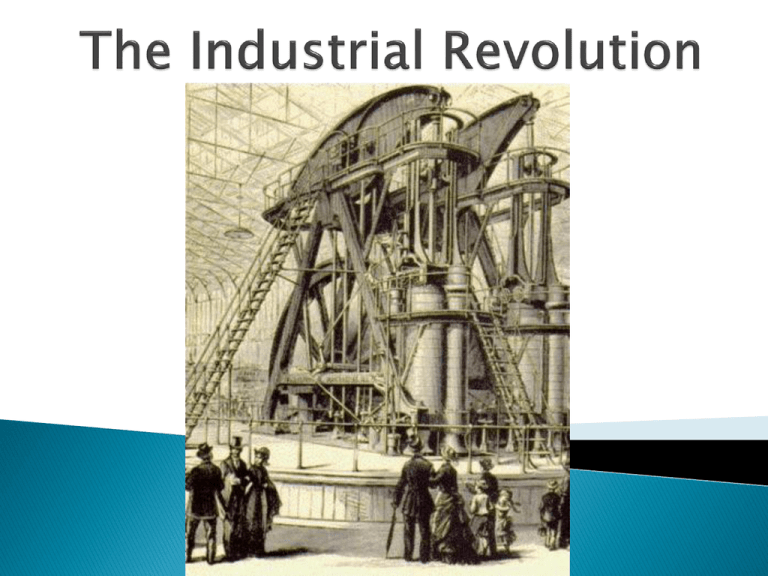
The Industrial Revolution ◦ Started in Britain ◦ Saw a shift in simple hand tools to complex machines ◦ New sources of power replaced human and animal power In 1750 most people worked the land using handmade tools People did not know much about the world outside of their own village By 1850 many country villages had turned into industrial towns and cities Invention rapidly increased ◦ ◦ ◦ ◦ ◦ ◦ ◦ ◦ 1855 – First anesthetic was used First sewing machine Antiseptic invented Steam Power invented – James Watt Steam Engine invented Cotton Gin invented Skyscrapers invented Steelworks invented Industrial age led to travel by train or steamship People could communicate through the telegraph A New Agricultural Revolution ◦ Created dikes ◦ Used fertilizer ◦ Studied the soil and used crop rotation ◦ Created the seed drill ◦ Industrialization required fewer workers = higher profits ◦ Most village farmers were put out of business They moved to the cities to look for work Unprecedented growth ◦ Population of Britain grew from 5 to 9 million ◦ Population of Europe grew from 120 to 190 million Improved energy ◦ Water mills ◦ Windmills ◦ Coal Improved Iron ◦ Smelt Iron – separates iron from it’s ore ◦ Led to high quality iron Britain is the first country to industrialize – Why? ◦ Resources – Large supplies of coal and iron – large working force ◦ New Technology – Plenty of skilled mechanics who were eager to meet growing demand for new inventions ◦ Economic Conditions – Britain was wealthy and looking for new ventures ◦ Political and Social Conditions – Stable government where taking economic chances was encouraged Changes in the Textile Industry ◦ Cloth from India became very popular ◦ Increased demand for cloth in Britain ◦ Spinning Jenny invented in 1764 Increased cloth production 10 fold ◦ First Factories – places that brought together workers and machines to produce large quantities of goods ◦ More production = more money Revolution in Transportation On Land Steam locomotive & railroads Railroads made shipping goods very easy Turnpikes – roads built by capitalists – charged money to use On Sea Steamboat Steam freighters Could carry 10 to 20 times the amount of cargo that a wooden ship could carry Urbanization – Movement of people to cities Changes in farming, soaring population growth and increase in demand for workers led to Urbanization Air became polluted in industrialized cities Many workers were packed into tenements (small apartments) Living conditions for workers were terrible Tenements ◦ No running water ◦ No bathrooms or sanitation system ◦ No garbage areas ◦ Cholera spreads rapidly ◦ These cities become known as slums ◦ When was the last time we learned about human waste and garbage in the streets? The Black Death The Factory System ◦ Rigid Discipline 12-16 hour shifts men, women and children exhaustion led to many accidents many lost limbs, got black lung, white lung or died Workers were fired if they were sick Then went home to feed families and deal with sickness Life sucked ◦ Women Workers Worked same hours and made less What is Urbanization? Why did it occur? Describe a Tenement? Who lived there? What disease spread through most slums? What was the length of an average work shift during the Industrial Revolution? Why were children valuable to the work force? What were 2 Pro’s of the Industrial Revolution? 2 Cons? Mumbai is in this country? Why was it in the news last week? Where did the Industrial Revolution start? What were the 4 reasons it started there? How did the Industrial Revolution lead to the formation of large cities? What were some sources of power that were used during the Industrial Revolution? What disease spread through most slums? What was the length of an average work shift during the Industrial Revolution? What happened to the population in England and Europe during the Industrial Revolution? Why? What is a turnpike? A car bomb was detonated yesterday in this country killing 118 and injuring 200. Child Labor ◦ Small fingers made it easier to work with machine parts ◦ Small frames allowed them to squeeze into narrow mine shafts ◦ Many orphans were “bought” by corporations and used for labor You have just worked a 12 hour day at a coal mine or textile factory. In your binder write a letter to your parents describing your new job and whether or not you want to continue working. Strikes and labor unions were outlawed ◦ 12 killed in a protest in Manchester, England Methodism spreads throughout the slums ◦ Methodists adopted sober, moral ways and stressed a personal sense of faith New Middle Class ◦ Many did benefit from the Industrial revolution Investors, entrepreneurs and inventors The New Middle Class ◦ Ladies were encouraged to become “ladylike” ◦ They took up embroidery, drawing and piano ◦ Ladies did not work – they hired maids ◦ Women educated their children ◦ Had little sympathy for the poor Middle class felt the poor were responsible for their own misery or that they were lazy and ignorant Since Oak Park is an affluent area, what is your opinion of poor people? In your binder write whether you agree with the English Middle Class of the Industrial revolution or if you think differently What was thought about strikes and unions at the beginning of the Industrial Revolution? Who made up the new Middle Class? What branch of Christianity swept through the slums? What were some characteristics of being “lady like”? Why were children valuable to the work force? Introduce Project Many workers called for labor unions Eventually working class men gained the right to vote Con’s to the Industrial Revolution ◦ ◦ ◦ ◦ ◦ Low pay initially Unemployment Dismal working conditions Slums & Disease Social problems ◦ ◦ ◦ ◦ ◦ Demand for mass produced goods More jobs were available Wages eventually rose Cost of travel fell Opportunities increased Pro’s to the Industrial revolution Successful people of the Industrial Revolution embraced Laissez-faire economics What does this mean? They embraced Adam Smith’s “The Wealth of Nations” Where have we seen this before? Thomas Malthus predicted that the economic growth would outpace the food supply ◦ He said that society needed checks on population such as war, disease and famine ◦ If not the poor would suffer ◦ Malthus urged families to have less children David Ricardo ◦ Argued that when wages were high people had more children and this provided more people for the work force which lowered wages and led to higher unemployment After Malthus and Ricardo economics became known as the “dismal science” They both opposed government help for the poor In your binder write whether or not you think poor people in the United States should get Welfare or any other help from the government Utilitarianism – the greatest happiness for the greatest number of people Socialism emerges ◦ Socialists argued that the only way to get rid of poverty and injustice was to adopt socialism Socialism – everyone owns and operates everything Socialists believed in the general good nature of people Socialists wanted to eliminate the gap between rich and poor Karl Marx ◦ Agreed with the ideas of socialism and wrote “The Communist Manifesto” ◦ Marx hated Capitalism ◦ Argued that all of history can be defined by the struggle between the “haves” and “have Nots” ◦ “Haves” = Bourgeoisie ◦ “Have Nots” = Proletariat ◦ Marx felt that the Proletariat would eventually revolt and take over the world Belgium follows Britain’s lead in the Industrial Revolution Germany, France and the United States shortly follow The United States eventually becomes the leading Industrial Power in the world Eastern nations did not Industrialize as fast as Western nations Russia eventually Industrializes after a long period of social and political unrest Western Nations become dominant Companies began to hire scientists and researchers to make machines and products better Most nations measured their success based on the amount of steel they outputted Nations started to experiment with chemicals ◦ Alfred Nobel invents dynamite In the Late 1800’s electricity replaced steam as the dominant source of Industrial power ◦ Alessandro Volta – creates first battery ◦ Michael Faraday – creates first dynamo (machine that generates electricity) ◦ Thomas Edison – creates first light bulb Electricity allowed factories to work after dark What form of economy usually goes with Democracy? Why was Economics known as the “Dismal Science” during the Industrial revolution? What is Laissez-faire economics? How is Socialism different than Capitalism? What did Thomas Malthus predict would happen? What did David Ricardo predict? Who invented the Dynamo? Who invented the first battery? Who invented the light bulb? Who invented the steam engine? The Prime Minister of this country was attacked this weekend by a mentally disturbed man. The Prime Minister was left with a broken nose and several broken teeth. Companies begin to design products with interchangeable parts ◦ Assembly Line created ◦ Both of these increased production Automobile Age begins ◦ Invented in Germany by Nikolaus Otto, Karl Benz and Gottlieb Daimler ◦ Improved upon by Henry Ford ◦ People laughed at these “horseless carriages” Assembly Line Activity Conquest of the Air ◦ Orville and Wilbur Wright flew the “Kitty Hawk” in 1903 ◦ Commercial flight begins in the 1920’s Rapid Communication ◦ Samuel Morse invents Morse code for telegraph - 1844 ◦ Alexander Graham Bell invents the Telephone - 1876 ◦ Guglielmo Marconi invents the radio - 1890 New Directions for Business ◦ Businesses began to sell stock ◦ Corporations begin to form ◦ A movement towards monopolies Monopolies buy everything they can and eliminate the competition Once the competition is gone they can raise the prices to any level they want ◦ Sometimes monopolies would form together to form a cartel ◦ Many call for regulation against monopolies and cartels ◦ In your binder write about your opinion of monopolies and cartels Between 1800 and 1900 the world population doubles ◦ This is not because families were larger ◦ It is because the death rate decreased People ate better and medical advances allowed for this ◦ Germ Theory Louis Pasteur discovered the link between germs and disease He also created vaccines for these germs and microbes Created the process of pasteurization – filtering milk Florence Nightingale ◦ Cleaned up hospital conditions Urban Renewal ◦ Repairing the poor areas of cities ◦ Sidewalks, Sewers, Street Lights, Police & Fire Departments, Clean Water ◦ Slums continued to exist in the poorest outskirts of cities Labor Unions ◦ Fought for workers rights ◦ Helped increase the standard of living A new social order ◦ For the first time in history the upper class included the self made rich ◦ Young people had more of a choice who they married ◦ The rights of women were promoted – woman’s suffrage ◦ Public education is promoted ◦ Higher education is promoted ◦ Charles Darwin – “The Origin of Species” – evolution ◦ Social Darwinism – survival of the fittest amongst people Helped encourage racism What is the order of nations that Industrialized first? Who eventually becomes the leading industrialized nation? What did Alessandro Volta invent? What did Michael Faraday invent? What did Thomas Edison invent? What did Guglielmo Marconi invent? What did Alexander Graham Bell invent? What did Nikolaus Otto invent? What did the Wright Brothers do? What did electricity allow factories to do? Explain what stock is.

